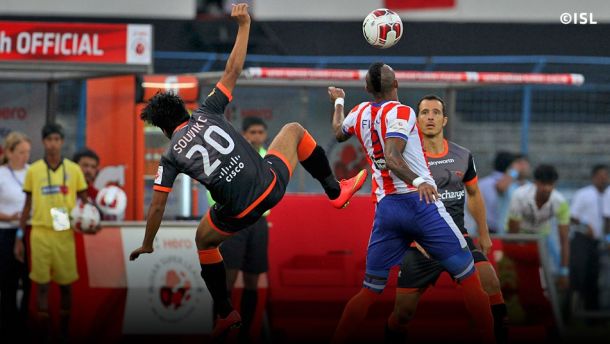The Hero Indian Super League is one that is often viewed in comparison to Major League Soccer in the United States. Owners run "franchises" that are not necessarily independent clubs, and there were drafts that determined which players ended up where. Oh, and there's no promotion into the Super League, or relegation out of it, unless an owner decides to shut his "franchise's" operations, or new owners buy in.
But strangely, the ISL has been praised by promotion/relegation advocates in the United States for "not claiming to be Division 1." That is a rhetorical question, given that the league only lasts for two months anyway. The regular I-League (Division 1, Division 2, etc.) starts up in December once the ISL finishes up, and none of the clubs that took part in the ISL will take on the challenge of the I-League. If they did, they would have to cut ties with all but two of their non-Asian foreign players.
The first season is only three matches in, and we cannot make any judgments about the long-term success of the ISL. So far, good crowds (not necessarily sellouts, but still larger than the crowds I-League matches have drawn, and potentially their television revenue) have taken to see the likes of Elano, Alessandro del Piero, Elias, Joan Capdevila, David Trezeguet, Robert Pires, and others show what they can do on the subcontinent for franchises from their cities.
There have been plenty of golazos--includes an Elias direct costless kick goal, a Fikru juggling goal, and plenty of goals on long-balls over the top and back heel one-twos, as one might see in *gasp* MLS. But of the 18 goals scored in the league, all but two have been scored by foreign players. While such numbers between foreign players and USA (or Canadian players) is not kept by MLS, one can imply that domestic players--including Gyasi Zardes, Clint Dempsey, Lee Nguyen, Chris Wondolowski, Luis Silva, are doing a much larger part of the heavy lifting in terms of scoring.
There are also plenty of players with enough inventiveness and a strong enough range of passing to create chances that directly lead to the goals as well, including Benny Feilhaber, Landon Donovan, Dillon Powers, Perry Kitchen (a holding midfield player), Diego Fagundez, Luis Gil and Wil Trapp, and domestic players who can tackle without a harsh foul, can control the ball under pressure, etc. In comparison to the ISL (and I-League), these domestic players are what Indian fans really would covet.
But unfortunately, the goals by Indian players have not been one displaying much in the way of technical ability. And those were set up by the foreign players' shots, and are likely to continue to be set up by the expensive foreign players. And those goals came off of scraps inside the six yard box after spilled shots that MLS keepers would routinely be able to hold. Many of the Super League goals, or touches have been at least been helped by breakdowns in communication between Indian and foreign defenders, and poor touches in buildup play (especially by some of the native players). Of the bookings, over 50% have been against Indian players, with an Indian receiving the only red card given so far in the ISL season. Many of those bookings were obvious from most footballing standards, and did not need embellishment.
This leads to an obvious explanation of "Why create the Indian Super League?" It's obvious the league is a marketing shtick to try to generate interest in domestic soccer in India. Why a new "short tournament" and not more money into teams already participating in the I-League, or into more I-League teams to make the pyramid stronger? A country of one billion people should be able to support hundreds of teams in such a pyramid, with the level of support afforded too many teams in France, or Brazil, or even (gasp) Mexico or the USA. But if the players cannot execute a simple overlap play, or play a side-footed pass, or control the ball, turn and pass in one or two motions, or string at least four-to-five passes together to dis-mark defenders (as part of an offensive buildup) or tackle the ball without fouling, it doesn't matter what the system the teams are playing in. They will not draw a crowd because they simply are not good enough for people to think the game is good entertainment without being inebriated.
This is the gap. It's in fundamental skills soccer players should be able to have, regardless of whether they play street ball or soccer for fun, showbol, futsal, or professionally under the lights. The AIFF has to recognize that a league filled with foreign players cannot bring meaning and culture to an entire subcontinent for a long time. It only covers up the fact that it has not spent time, or sponsors' money on helping to build the soccer culture at its grassroots--one which encourages parents to teach proper technique to kids, and for kids to teach each other (and one up each other) on improvised pitches, and one where creativity is developed away from formal education.
No amount of coaching or foreign players can replace a proper soccer culture in which the domestic players are technically good enough to provide a competitive team on their own, and could potentially lead India to a soccer World Cup (appearance, at the minimum). This will sustain the promotion and relegation pyramid, and would disincentivize the need for an MLS-style system.
Without the technical quality of USA players making substantial improvements since the ASL and NASL days of the 1950s and 1960s and even up to the early days of MLS, those who engage in a promotion and relegation debate about club soccer in the USA would not be able to do so with much credibility. In India, and other Asian nations where the domestic players are nowhere near good enough to sustain a competitive team without paying above market value for good enough foreign players, the fundamental flaws demonstrate why the AIFF had to create a gimmick to generate domestic interest.






































